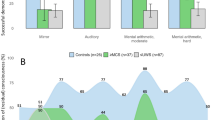Summary
During heat stress in domestic pigeons (Columba livia, mean mass 0.43 kg) brain temperature (T B) varied in parallel with colonic temperature (T c). The difference between these (T C−T B=ΔT) averaged 0.7°C and was not significantly altered when the animal breathed through a trachael cannula bypassing the buccopharyngeal cavity. When we sealed the nares and beak in bypass animals, ΔT was significantly reduced but was nevertheless maintained at 0.4°C. When the eyes were sealed as well, however, ΔT was reversed, amounting to −0.4°C. Conversely, with eyes sealed but beak and nares open, ΔT was indistinguishable from that in controls. These results suggest a role for the cornea in evaporative cooling, at least when respiratory evaporation is impaired, and are consistent with the hypothesis that buccopharyngeal and corneal evaporation are coupled to brain cooling. The probable mechanism for this coupling is the flow of venous blood from evaporative surfaces through theretia mirabilia in the temporal areas. Here heat is transferred from the warmer arterial blood flowing through theretia toward the brain to the centrally flowing, cooler venous blood.
Similar content being viewed by others
References
Kilgore, D.L., Jr., Bernstein, M.H., Schmidt-Nielsen, K.: Brain temperature in a large bird, the rhea. Am. J. Physiol.225, 739–742 (1973)
Kilgore, D.L., Jr., Bernstein, M.H., Hudson, D.M.: Brain temperature in birds. J. comp. Physiol.110, 209–215 (1976)
Kilgore, D.L., Jr., Boggs, D.F., Birchard, G.F.: Role of therete mirabile ophthalmicum in Maintaining the Body-to-Brain Temperature Difference in Pigeons. J. comp. Physiol.129, 119–122 (1979)
Magilton, J.H., Swift, C.S.: Response of veins draining the nose to alar-fold temperature changes in the dog. J. Appl. Physiol.27, 18–20 (1969)
Richards, S.A.: Brain temperature and the cerebral circulation in the chicken. Brain Res.23, 265–268 (1970)
Scott, N.R., Tienhoven, A. van: Simultaneous measurement of hypothalamic and body temperatures and heart rate of poultry. Trans. Am. Soc. Agr. Eng.14 1027–1033 (1971)
Weathers, W.W., Schoenbaechler, D.C.: Contribution of gular flutter to evaporative cooling in Japanese quail. J. Appl. Physiol.40, 521–524 (1976)
Wingstrand, K.G., Munk, O.: The pecten oculi of the pigeon with particular regard to its function. Biol. Skrifter14, 1–64 (1965)
Author information
Authors and Affiliations
Rights and permissions
About this article
Cite this article
Bernstein, M.H., Sandoval, I., Curtis, M.B. et al. Brain temperature in pigeons: Effects of anterior respiratory bypass. J Comp Physiol B 129, 115–118 (1979). https://doi.org/10.1007/BF00798174
Accepted:
Issue Date:
DOI: https://doi.org/10.1007/BF00798174




